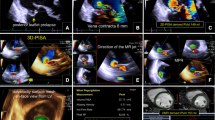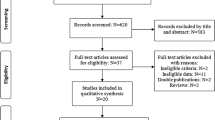Abstract
This study was intended to evaluate the diagnostic value of three dimensional proximal isovelocity surface area (3D PISA) derived effective regurgitant orifice area (EROA) and the accuracy of automatic 3D PISA detection in a population resembling clinical practice. Quantification of mitral regurgitation (MR) remains challenging and 3D PISA EROA is a novel diagnostic tool with promising results. However its’ usefulness compared to guideline endorsed parameters has not been shown. In 93 consecutive patients examined in routine practice conventional parameters and 3D-datasets for offline 3D PISA evaluation were recorded. EROA was determined from the largest (peak) PISA and also averaged over systole for meanEROA. Results of 3D PISA calculation were compared with a combination of expert grading by two examiners and two scores for MR grading. In receiver operator characteristic-analysis the meanEROA as determined by 3D PISA had the best diagnostic value (AUC = 0.907 CI 0.832–0.983) as compared to peakEROA (AUC 0.840 CI 0.739–0.941), vena contracta width (AUC 0.831 CI 0.745–0.918) and 2D PISA (AUC 0.747 CI 0.644–0.850). A meanEROA of 0.15 cm2 had a sensitivity of 88.2 % and a specificity of 81.4 % for distinguishing severe from non-severe MR. Semiautomatic 3D PISA detection correlated very well with manually corrected values (r = 0.955). Semiautomatic 3D PISA measurement is feasible in a clinical population and has better diagnostic value compared to 2D PISA. Calculation of mean EROA throughout systole further improves diagnostic value compared to conventional parameters.






Similar content being viewed by others
Abbreviations
- 2D:
-
Two dimensional
- 3D:
-
Three dimensional
- AR:
-
Aortic regurgitation
- AUC:
-
Area under the curve
- BMI:
-
Body mass index
- bpm:
-
Heatbeats per minute
- CAD:
-
Coronary artery disease
- CKD:
-
Chronic kidney disease
- COPD:
-
Chronic obstructive pulmonary disease
- E/E′:
-
Early mitral inflow velocity/early mitral annulus velocity
- EDV:
-
Enddiastolic volume
- EROA:
-
Effective regurgitation orifice area
- ICC:
-
Intraclass correlation coefficient
- LA:
-
Left atrium
- LVEF:
-
Eleft ventricular jection fraction
- MR:
-
Mitral regurgitation
- NYHA:
-
New York Heart Association classification
- PISA:
-
Proximal isovelocity surface area
- PMR:
-
Primary mitral regurgitation
- ROC:
-
Receiver operator characteristic
- RVol:
-
Regurgitation volume
- SD:
-
Standard deviation
- SMR:
-
Secondary mitral regurgitation
- sPAP:
-
Systolic pulmonary artery pressure
- VC:
-
Vena contracta width
- VCA:
-
Vena contracta area
References
Bargiggia GS, Tronconi L, Sahn DJ, Recusani F, Raisaro A, De Servi S et al (1991) A new method for quantitation of mitral regurgitation based on color flow Doppler imaging of flow convergence proximal to regurgitant orifice. Circulation 84:1481–1489
Zoghbi WA, Enriquez-Sarano M, Foster E, Grayburn PA, Kraft CD, Levine RA et al (2003) Recommendations for evaluation of the severity of native valvular regurgitation with two-dimensional and Doppler echocardiography. J Am Soc Echocardiogr 16:777–802
Lancellotti P, Moura L, Pierard LA (2010) European Association of Echocardiography. European Association of Echocardiography recommendations for the assessment of valvular regurgitation. Part 2: mitral and tricuspid regurgitation (native valve disease). Eur J Echocardiogr 11:307–332
Vahanian A, Alfieri O, Andreotti F, Antunes MJ, Baron-Esquivias G, Baumgartner H et al (2012) Guidelines on the management of valvular heart disease (version 2012): the Joint Task Force on the Management of Valvular Heart Disease of the European Society of Cardiology (ESC) and the European Association for Cardio-Thoracic Surgery (EACTS). Eur Heart J 33:2451–2496
Enriquez-Sarano M, Miller FAJ, Hayes SN, Bailey KR, Tajik AJ, Seward JB (1995) Effective mitral regurgitant orifice area: clinical use and pitfalls of the proximal isovelocity surface area method. J Am Coll Cardiol 25:703–709
Pu M, Vandervoort PM, Greenberg NL, Powell KA, Griffin BP, Thomas JD (1996) Impact of wall constraint on velocity distribution in proximal flow convergence zone. Implications for color Doppler quantification of mitral regurgitation. J Am Coll Cardiol 27:706–713
Iwakura K, Ito H, Kawano S, Okamura A, Kurotobi T, Date M et al (2006) Comparison of orifice area by transthoracic three-dimensional Doppler echocardiography versus proximal isovelocity surface area (PISA) method for assessment of mitral regurgitation. Am J Cardiol 97:1630–1637
Matsumura Y, Fukuda S, Tran H, Greenberg NL, Agler DA, Wada N et al (2008) Geometry of the proximal isovelocity surface area in mitral regurgitation by 3-dimensional color Doppler echocardiography: difference between functional mitral regurgitation and prolapse regurgitation. Am Heart J 155:231–238
Kahlert P, Plicht B, Schenk IM, Janosi RA, Erbel R, Buck T (2008) Direct assessment of size and shape of noncircular vena contracta area in functional versus organic mitral regurgitation using real-time three-dimensional echocardiography. J Am Soc Echocardiogr 21:912–921
Altiok E, Hamada S, van Hall S, Hanenberg M, Dohmen G, Almalla M et al (2011) Comparison of direct planimetry of mitral valve regurgitation orifice area by three-dimensional transesophageal echocardiography to effective regurgitant orifice area obtained by proximal flow convergence method and vena contracta area determined by color Doppler echocardiography. Am J Cardiol 107:452–458
Li X, Shiota T, Delabays A, Teien D, Zhou X, Sinclair B et al (1999) Flow convergence flow rates from 3-dimensional reconstruction of color Doppler flow maps for computing transvalvular regurgitant flows without geometric assumptions: an in vitro quantitative flow study. J Am Soc Echocardiogr 12:1035–1044
Yosefy C, Levine RA, Solis J, Vaturi M, Handschumacher MD, Hung J (2007) Proximal flow convergence region as assessed by real-time 3-dimensional echocardiography: challenging the hemispheric assumption. J Am Soc Echocardiogr 20:389–396
Little SH, Igo SR, Pirat B, McCulloch M, Hartley CJ, Nose Y et al (2007) In vitro validation of real-time three-dimensional color Doppler echocardiography for direct measurement of proximal isovelocity surface area in mitral regurgitation. Am J Cardiol 99:1440–1447
Pirat B, Little SH, Igo SR, McCulloch M, Nose Y, Hartley CJ et al (2009) Direct measurement of proximal isovelocity surface area by real-time three-dimensional color Doppler for quantitation of aortic regurgitant volume: an in vitro validation. J Am Soc Echocardiogr 22:306–313
Sitges M, Jones M, Shiota T, Qin JX, Tsujino H, Bauer F et al (2003) Real-time three-dimensional color Doppler evaluation of the flow convergence zone for quantification of mitral regurgitation: validation experimental animal study and initial clinical experience. J Am Soc Echocardiogr 16:38–45
Grady L, Datta S, Kutter O, Duong C, Wein W, Little SH et al (2011) Regurgitation quantification using 3D PISA in volume echocardiography. Med Image Comput Comput Assist Interv 14:512–519
Cobey FC, McInnis JA, Gelfand BJ, Rapo MA, D’Ambra MN (2012) A method for automating 3-dimensional proximal isovelocity surface area measurement. J Cardiothorac Vasc Anesth 26:507–511
de Agustin JA, Marcos-Alberca P, Fernandez-Golfin C, Goncalves A, Feltes G, Nunez-Gil IJ et al (2012) Direct measurement of proximal isovelocity surface area by single-beat three-dimensional color Doppler echocardiography in mitral regurgitation: a validation study. J Am Soc Echocardiogr 25:815–823
Thavendiranathan P, Liu S, Datta S, Rajagopalan S, Ryan T, Igo SR et al (2013) Quantification of chronic functional mitral regurgitation by automated 3-d peak and integrated proximal isovelocity surface area and stroke volume techniques using real-time 3-D volume color Doppler echocardiography. In vitro and clinical validation. Circ Cardiovasc Imaging 6:125–133
Schwammenthal E, Chen C, Benning F, Block M, Breithardt G, Levine RA (1994) Dynamics of mitral regurgitant flow and orifice area. Physiologic application of the proximal flow convergence method: clinical data and experimental testing. Circulation 90:307–322
Buck T, Plicht B, Kahlert P, Schenk IM, Hunold P, Erbel R (2008) Effect of dynamic flow rate and orifice area on mitral regurgitant stroke volume quantification using the proximal isovelocity surface area method. J Am Coll Cardiol 52:767–778
Quinones MA, Douglas PS, Foster E, Gorcsan Jr, Lewis JF, Pearlman AS et al (2003) American College of Cardiology/American Heart Association clinical competence statement on echocardiography: a report of the American College of Cardiology/American Heart Association/American College of Physicians–American Society of Internal Medicine Task Force on Clinical Competence. Circulation 107:1068–1089
Buck T, Plicht B (2006) Erbel R [Current recommendations on echocardiographic evaluation of the severity of mitral regurgitation: standardization and practical application using a scoring system]. Herz 31:30–37
Thomas L, Foster E, Hoffman JI, Schiller NB (1999) The Mitral Regurgitation Index: an echocardiographic guide to severity. J Am Coll Cardiol 33:2016–2022
Lancellotti P, Gerard PL, Pierard LA (2005) Long-term outcome of patients with heart failure and dynamic functional mitral regurgitation. Eur Heart J 26:1528–1532
Conflict of interest
No conflicts of interest were declared by the authors.
Author information
Authors and Affiliations
Corresponding author
Electronic supplementary material
Below is the link to the electronic supplementary material.
Rights and permissions
About this article
Cite this article
Schmidt, F.P., Gniewosz, T., Jabs, A. et al. Usefulness of 3D-PISA as compared to guideline endorsed parameters for mitral regurgitation quantification. Int J Cardiovasc Imaging 30, 1501–1508 (2014). https://doi.org/10.1007/s10554-014-0496-7
Received:
Accepted:
Published:
Issue Date:
DOI: https://doi.org/10.1007/s10554-014-0496-7




